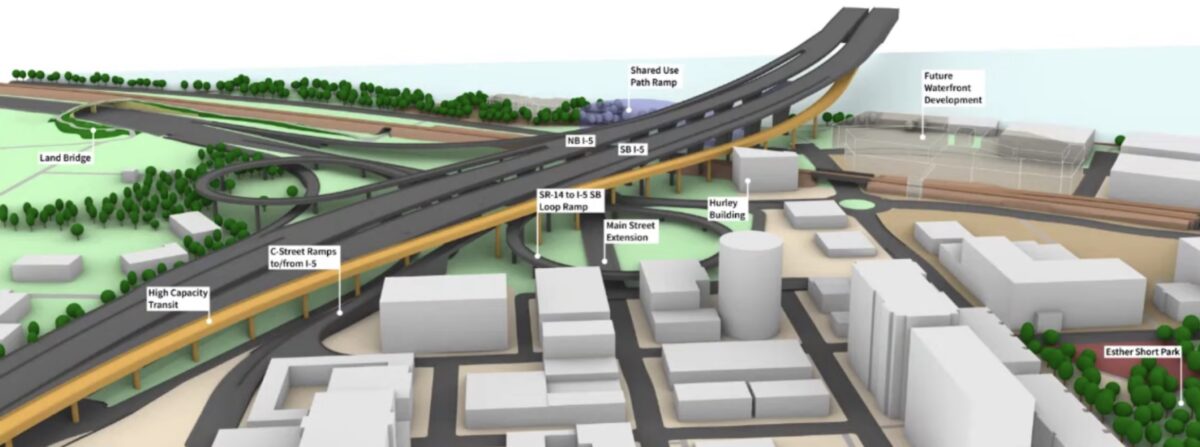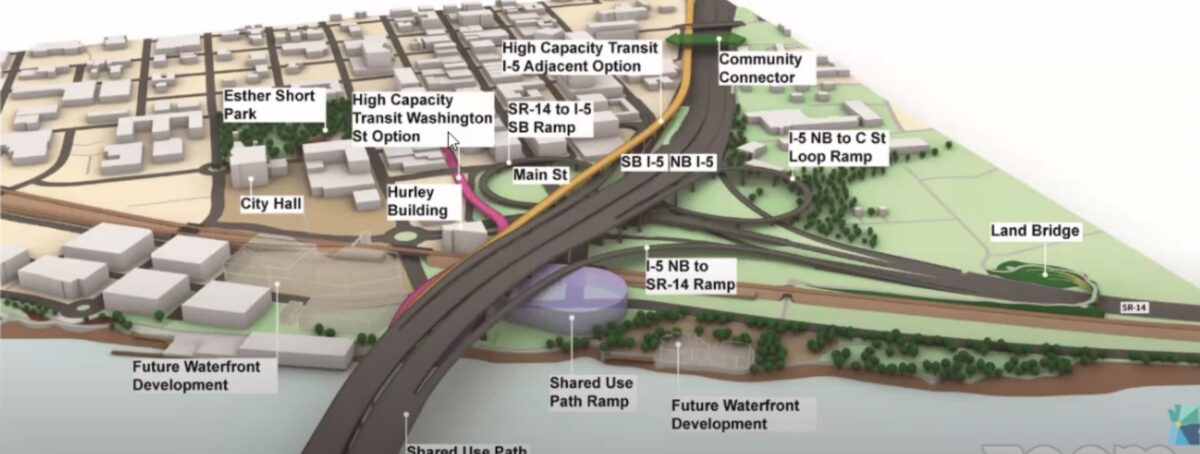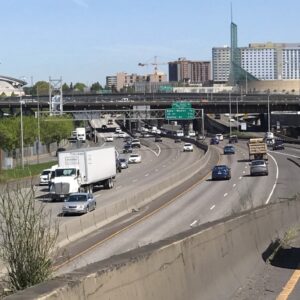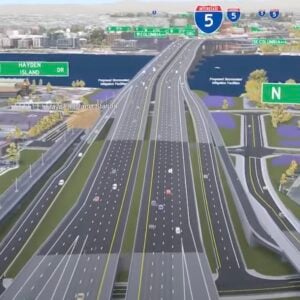

(Source: Interstate Bridge Replacement Program)
Elected officials working on the expansion of Interstate 5 between Oregon and Washington this week got a look at early renderings (more below) of the narrow set of options for the new highway, focused around downtown Vancouver.
“I know the moment this is shared, social media and everybody else is going to want to publish all of this information.”
— Anne McEnerny-Ogle, Vancouver Mayor
These renderings weren’t available in advance of the Interstate Bridge Replacement Program (IBR) Executive Steering Group’s Thursday meeting and as of the time of publication still had not been posted, suggesting they are being held close to the vest. During the meeting, the group discussed the possibility of the images being taken out of context, with one member suggesting they come with a disclaimer. “I know the moment this is shared, social media and everybody else is going to want to publish all of this information. We know it’s very high level, we know it’s conceptual, we want to make sure it doesn’t represent any decisions that are being made, that we are working toward that process,” Anne McEnerny-Ogle, Vancouver Mayor said.
Program administrator Greg Johnson noted that the designs were “still in the talking stages” but that they were being shared with groups like the Cowlitz Tribe to get their feedback on the project’s impact on Fort Vancouver.


Shown were the two major choices for the ten-lane highway: two bridges side-by-side or stacked on top of each other. Both loom over downtown Vancouver. What they don’t show is how the new highway would look to someone at ground level in Vancouver’s growing downtown.
The renderings won’t surprise anyone who has seen the proposals developed for the Columbia River Crossing a decade ago, but reiterate what a major impact a new elevated ten-lane highway would make in Vancouver.
Advertisement

Moments after these renderings were shared on Twitter Thursday while the meeting was taking place, the IBR team sent a statement attributed to Greg Johnson to ensure that they were not taken out of context. “It is important to note that the new visualizations feature more detail than what has been shown previously, but do not represent new options created for this exercise. These are intended to provide a 3-D illustration at a high level and are not representative of specific property impacts. As you know, we are still in the process of evaluating design options and determining which option may move forward to be incorporated into the IBR solution, with more design detail to be added as we are farther in the process,” the statement read.
The project team is still working on models that look at what influence high levels of demand management and transit investments could have on the three proposed designs for the highway, but we haven’t seen the results of that even as we start to see conceptual renderings.
Not shown was any rendering of what the highway might look like on Hayden Island. A decade ago, Hayden Island was set to see the biggest impact from the Columbia River Crossing, with a significant number of properties permanently acquired for the project (shown in red below).
Advertisement

In December, the Hayden Island Neighborhood Network (HINooN) approved a resolution supporting a “no build” option for the IBR project, instead pushing for a third bridge over the Columbia River. Their resolution noted that the project was heading down the exact same path as the CRC.
“What is happening does not feel like equity for us at all. We are against the massive intrusion over the island.”
— Jan Roxburgh, Hayden Island resident
Hayden Island resident Jan Roxburgh is one of many who don’t support the current project. “What is happening does not feel like equity for us at all. More like further traumatizing,” she shared with us via email this week. “Our community would be destroyed by what IBRP proposes. It is like the CRC just being regurgitated. It seems unreal that this same old story is being played out now in the light of more knowledge available about the dangers that are presented by climate change.”
“We are against the massive intrusion over the island,” Roxburgh continued. “Their plan is a massive freeway footprint over the island. What do we get in exchange for all this destruction? We get to save a minute and a half off our commute time during rush hour. The promise to climate change and equity are only empty words on paper.”
The project team is currently in a race to get a modified Locally Preferred Alternative (LPA) selected by this summer, even as it looks like the Washington legislature may not appropriate any construction funding for the IBR until 2023. Last week, President Joe Biden listed the project as one of the most “economically significant bridges” in the country, a mention that Greg Johnson said put “wind in our sails” as they work to design the new highway.
On the heels of the Oregon Department of Transportation receiving word that the Federal Highway Administration has rescinded the Finding of No Significant Impact for the Rose Quarter highway expansion project and is requiring more environmental review of that project, the IBR is seeking to get through the federal environmental approval process as quickly as possible.






Thanks for reading.
BikePortland has served this community with independent community journalism since 2005. We rely on subscriptions from readers like you to survive. Your financial support is vital in keeping this valuable resource alive and well.
Please subscribe today to strengthen and expand our work.
Meet the new bridge, same as the old (CRC) bridge. Notice that the only views that the project releases are what you might see from a plane taking off or landing at PDX. This birdseye perspective is an old Robert Moses trick to make the bridge look smaller than it is. With a 110′ navigation clearance and huge approach ramps, the new bridge will tower over most of downtown Vancouver.
Project staff were falling all over themselves at the ESG meeting yesterday saying how they were planning to “manage the narrative” around these images. They’re claiming these are just a draft, but that’s clearly misleading. They have less than six months, according to their schedule to produce a new LPA design. This new proposal is a dead-ringer for the old one, and if they were serious about any alternatives, where are the JPGs that show what those would look like?
Thank you so much Ryan Packer and Bike Portland for giving Hayden Island a stronger voice! It has felt like our situation, living at ground zero of the IBRP’s plans for a massive replacement freeway bridge, has not been taken seriously. It feels like we are having to fight for survival as a community. I feel grateful that you shared some of our story.
Excellent point about Hayden Island.
Also, this is an rendering of the project near to zero people will experience (flying in the air over it). Real renderings would include renderings from the perspective of someone walking under the project, someone driving through the project, someone looking at the project from Main Street, people in buildings looking through their windows at it, and soforth. A highway expansion only looks pretty when it’s done in yellow from above.
Someone should make a meme replacing all the text bubbles (except “Community Connector”) into “Community Divider”
And people wonder why democracy is on life support in the US. Why bother voting or participating when those in charge continuously prove themselves incapable of delivering a vision of the future resembling anything compelling or, at the very least, responsive to the will of the people?
We rejected this horrid design 13 years ago and reject it now.
same with the Rose Quarter project.
Sorry if that hurts the masters of the universe who run these projects at huge engineering firms and local government bureaucrats but it’s simply the truth. Stop subverting the will of the majority of the people.
Yes its going to be very tall…based on the CRC studies (shipping access)…the bottom of any future bridge will be higher than the top of the current bridge’s lift spans.
Hey RacerX. The current clearance is 176 when the bridge is lifted. I haven’t heard the final number for the new bridge, but they were working towards 110 when the CRC was canceled.
The new bridge will be high and disruptive but not near the existing bridges clearance.
And as for Hayden island’s vote for the “3rd Bridge + No Build”…yes they could help end ALL of this IBR if they just petitioned to close ALL of the I-5 ramps to and from their zone and got ODOT to build their access from the south…thus ending much of the congestion friction and safety problems those ramps cause. Then we could look at smaller incramental solutions…
So they plan to continue to waste the most valuable land in Vancouver for at least 50 more years…if only there were studies of how cities work…
And sadly…the tunnel option has been dropped…imagine how much downtown Vancouver land could have been redeveloped into housing and waterfront access. (Yes, SR-14 connection to I-5 would be a bit out of direction…but DOTs do that all the time to peds and cyclists, so its all good 😉
They both look worse than what we have now.
Tunnel, please!
I hope cyclists are considered in these plans. It could be a wonderful opportunity to improve cycling routes (safer, easier, more pleasant, etc).
Why are cyclists left with only hope? What if non-car transportation were the #1 priority?
So the default HCT routing is right next to the freeway, completely bypassing downtown Vancouver? I’m glad they include an option to go downtown, but this is not encouraging. This shows that they are not serious about the transit element.
OMG just looked again and saw the overpass labled “community connector.” (In cheerful green, not gray concrete, of course). That’s quite a spin!
Can they now label the highway and expansion – in 160 point font – “Community divider”? Just to be really clear?
It’s as if they aren’t self-aware enough to realize the damage they’ve caused – and are adding to – and are instead thinking kindly of themselves for putting a bandaid over the open chest wound.
The 2007 rendering (looking south from Vancouver) of a single-deck bridge (instead of double-deck) I hadn’t yet seen though single-deck has since 2013 been my preference. I’d run an extension of the Vancouver BRT on this separate transit/ped span to Hayden Island instead of MAX. This span creates an EMERGENCY ACCESS corridor to SAVE LIVES in major collisions. MAX would have to stop, but buses could steer around stopped emergency vehicles. Single-deck bridges also provide MAXIMUM river clearance for shipping.